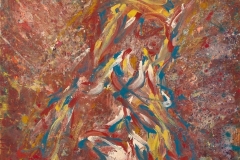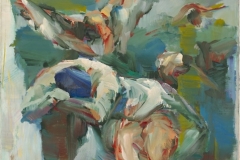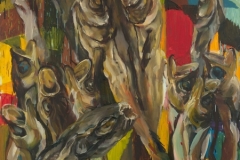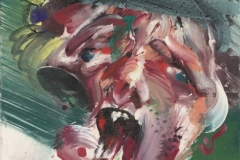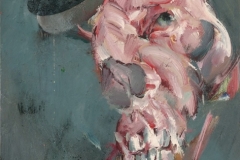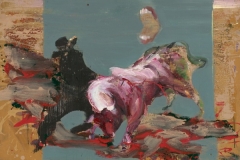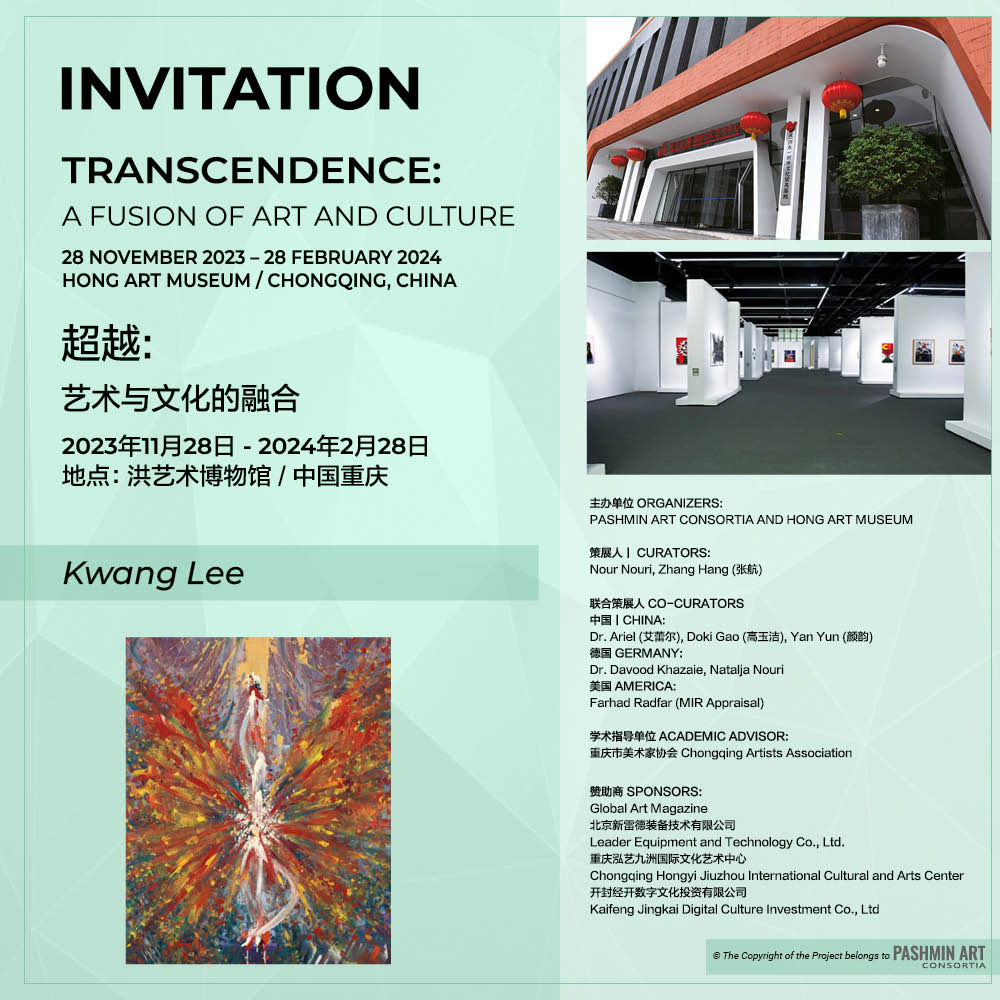
Kwang Lee, a native of South Korea, is a painter whose roots are deeply embedded in the vibrant culture of her homeland, yet refined amidst the rich artistic milieu of Germany. A student of the renowned Kunstakademie Düsseldorf and a protégé of Markus Lüpertz, Lee’s work embodies a confluence of cultures, melding the essence of East Asian traditions with the nuanced complexities of Western artistry.
Lee’s creations are not mere canvases but are stirring narratives rendered in color and form. Every stroke is imbued with the pulse of human experiences, drawing observers into an intricate dance of emotion and aestheticism. The artist’s palette, enriched with egg tempera, oil, and vibrant pigments, paints a mesmerizing portrayal of life’s dichotomies, illustrating themes of pain, death, and transience with an elegance that transcends the immediacy of suffering, revealing gateways to universal love and redemption.
Earlier works reflect Lee’s deep empathy, a sentiment carved from her own journey through diverse landscapes of human existence, especially during her times in Germany and India. Each piece, an invitation to an emotional pilgrimage, transcends geographical and temporal constraints, weaving a collective narrative of human anguish, love, and transcendental beauty.
At the Hong Art Museum, a testament to Lee’s evolving artistry is lucidly displayed. Six evocative pieces; “Butterfly,” “Hit the Sky,” “I Have No Regrets That Will Disappear,” “The Sea of Light,” “God of the Universe,” and “Purification of the Soul” depict the artist’s maturing mastery. Similar to the internationally renowned Korean video artist Nam June Paik, these artworks draw inspiration from the shamanistic traditions of her homeland. The creative process involves a performance that resembles a shamanistic ritual, blending elements of painting, song, and dance. This synthesis results in more than just visual compositions; it crafts soulful journeys that narrate the complexities of existence, echoing both the fleeting and enduring facets of life.
In the silent yet eloquent language of art, Kwang Lee unearths universal themes, echoing her unparalleled ability to weave form, narrative, and emotion into a mesmerizing dance of visual poetry that invites observers to transcend boundaries, step into shared human experiences, and embark on journeys of the soul that illuminate pathways to love, compassion, and redemption.
Jung Hyun Gallery
Ul, Piłsudskiego 74, 312C, Wrocław, Poland
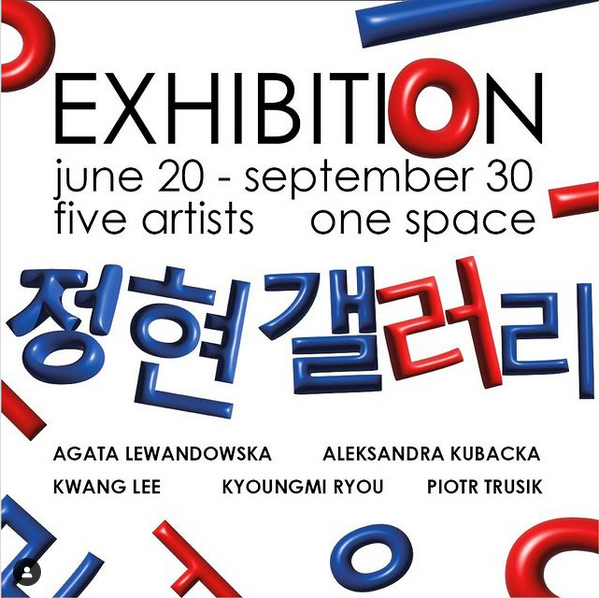
Events from the Past
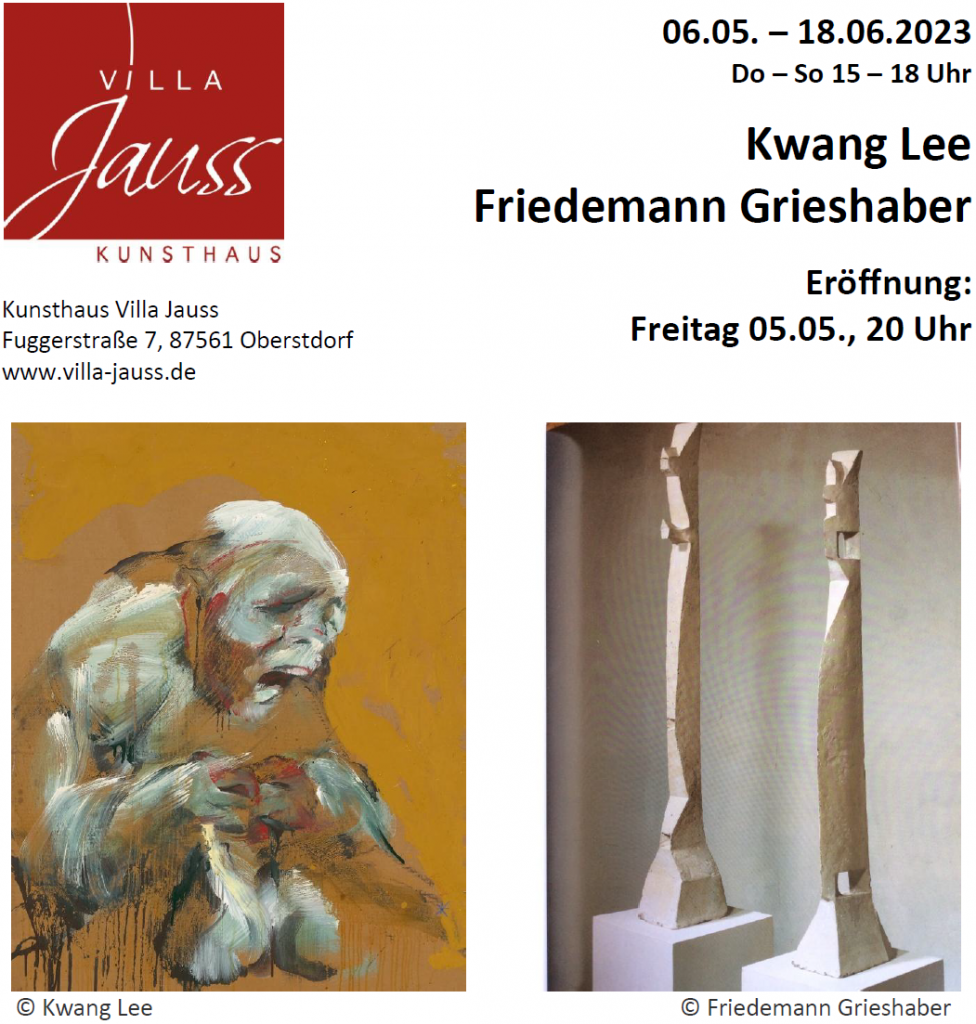
Kwang Lee
Kwang Lee umkreist in ihrer Malerei christliche Symbole, Paraphrasen auf Goya und Studien von Wasser und Licht. Es entwickeln sich während des Malvorganges ihre Formen zu tief empfundenen und oft fast abstrakten Kompositionen, wobei die Themen Mitleid und Heilung der Seele das geistige Fundament bilden.
Die in Korea geborene Kwang Lee studierte Malerei in Seoul und Düsseldorf, war Assistentin und Meisterschülerin bei Prof. Markus Lüpertz. Die Ausstellung in Oberstdorf zeigt als Retrospektive die Entwicklung ihrer Malerei. Figuration und Abstraktion wechseln sich in den frühen Bildern ab. Oft scheint die Welt durch dynamische Farb- und Formexplosionen zerstört und in Trümmern zu liegen und Gegenständliches ist nicht mehr zu erkennen. Mit der Anlehnung an Figuren von Grünewald, Goya, van Gogh und Francis Bacon tauchen danach Leid und Schmerz in den Arbeiten auf. Der gequält gezeigte Mensch erfordert die Einfühlung des Betrachters in den ewigen Kreislauf menschlicher Erniedrigung. Neue Bilder von 2022 nehmen mit der Serie „Schwarze Pieta“ diese Thematik gemildert im christlichen Kontext wieder auf. Es folgen diesem Tal der Schmerzen Bilderserien einer poetisch verzauberten Natur. Berliner Seeen und Davoser Berge bilden die Motive, doch mittels Malerei bekommen sie einen entrückten Farbklang, der beruhigte Ebenen des Betrachtens erreichen will.
Diese Zonen des Erlebens versucht die „Nirwana“ – Serie zu intensivieren. Parallel zur Musik entstanden z. B. in einer Art Schamanentanz der Performancemalerei „Kwangpunglyu“ wellenförmige Pinselüberlagerungen von Licht- und Wasserspuren, die eine Entgrenzung und Auflösung des Ichs anstreben im Sinne buddhistischer Lebensweisheiten. Ziel ist es, die leidende Seele des Menschen zu befreien.
Friedemann Grieshaber
Friedemann Grieshaber thematisiert mit seinen Skulpturen den Raum, komprimiert in Figur und Architektur. Dabei untersucht er formale Beziehungen von Innen und Außen und ergründet – im Prozess des Ordnens und der geistigen Durchdringung – den Bildcharakter und die plastische Dimension einfacher Baustoffe.
Friedemann Grieshaber wurde 1968 in Ravensburg geboren, lebt und arbeitet nach einem Studium der Bildhauerei (Stuttgart und Berlin) in Berlin-Pankow.Arbeiten von ihm befinden sich in öffentlichen und privaten Sammlungen. Strenge Formationen bestimmen den Kosmos dieses Künstlers. Er bearbeitet Raum mit den grundlegenden Erlebnisbereichen des Innen und Außen. Ein- und Ausblicke im Haus sind jedem Betrachter geläufig. Die Zusammenfügung von Figur und Architektur betont Gemeinsamkeiten in Aufbau und Tektonik, bekannt seit der Antike, der Renaissance und der Moderne. Dabei verstärken die Materialien Beton, Eisen und Bronze die strenge Komposition. Höhe, Breite und Tiefe, die Grundlagen des euklidischen Raumes und damit des Bauens schlechthin, werden fast puristisch vorgeführt. Ornament wäre ein Verbrechen. Ordnung und Formung beherrschen in vielen Variationsmöglichkeiten das Tun ihres Schöpfers. Die Balance von vor und zurück, von oben und unten erzeugt hoffentlich auch im Kunsthaus Villa Jauss Freude und Erstaunen beim Betrachter.
Exhibition “Black Pieta” in Seoul
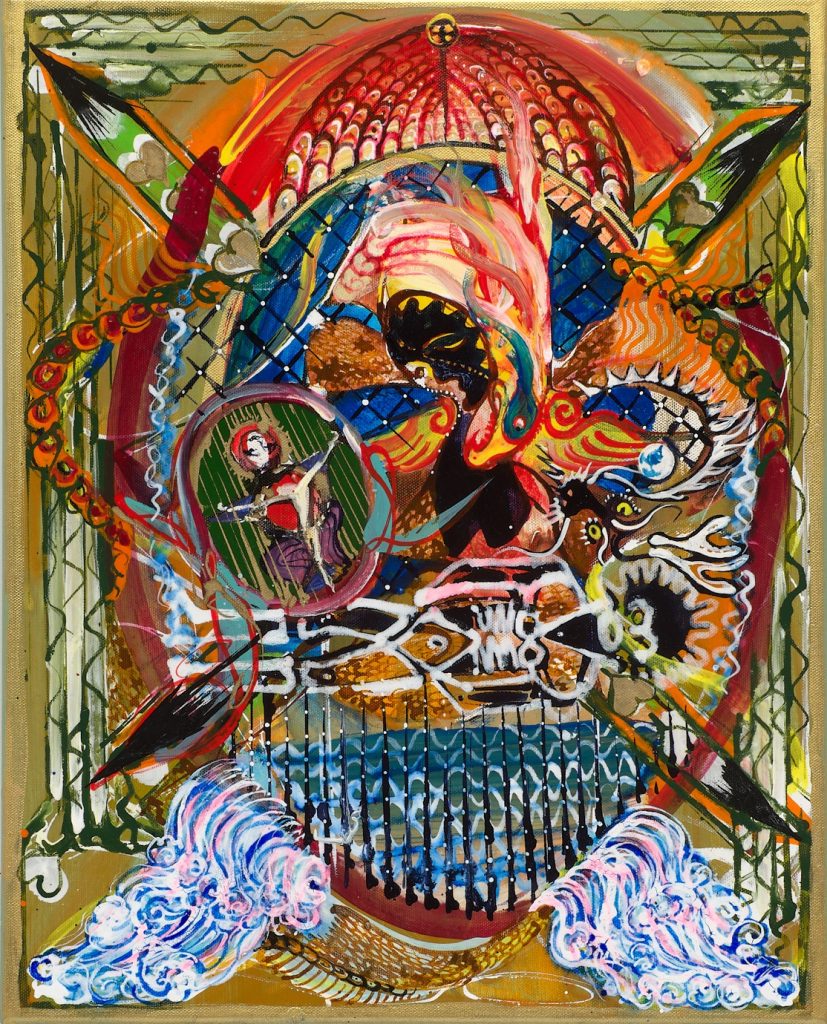
|
약자의 고통과 상처를 치유하는 현대 종교화
최광진(미술평론가)
근대 이전까지 미술의 주제는 대부분 종교화가 주류를 이루었고, 성전을 장식하거나 포교를 위해서 경전의 이야기를 작품의 모티브로 삼았다. 그래서 일반인과 다른 성인들의 거룩한 모 습을 도상을 통해 구분하거나 그들의 일화를 미화하여 표현했다. 그런데 과연 이런 종교적 도 상이나 일화로 사랑이나 자비 같은 종교의 본질을 표현할 수 있을까? 기독교 내부에서 한때 성상 파괴령이 내려진 것은 자칫 성상이 본질을 왜곡하는 우상이 될 우려가 있기 때문이다.
현대 작가들은 미술의 자율성을 명분으로 작품의 주제를 사회 현실이나 자신의 내면으로 전 환함으로써 종교에 봉사해 온 종교화의 전통에서 벗어나고자 했다. 그러나 베를린에 거주하며 활동하고 있는 이광의 작품은 기독교의 오랜 주제인 <피에타>를 통해 종교화의 전통을 현대 적으로 계승하고 있다는 점에서 주목된다. 그녀의 종교화는 기독교의 교리를 전하기 위한 도 구가 아니라 자신의 종교적 감정을 감각적으로 끌어내고 있다는 점에서 신표현주의적인 특징 을 보여준다. 그녀가 추구하는 종교적 감정이란 나와 남의 구분이 사라진 상태에서 가능한 사 랑과 용서, 그리고 약자에 대한 연민 같은 인간 본연의 마음이다.
그녀가 이러한 종교적 감정을 예술의 주제로 삼게 된 것은 운명적으로 대학 시절에 경험한 인도 여행에서 비롯된 듯하다. 인도에서 그녀는 길을 잃고 우연히 빈민촌에 들어가게 되었는 데, 그곳에서 길바닥에 시체처럼 누워 죽어가는 사람들의 장면을 목격하고 큰 충격을 받은 경 험이 있다. 그리고 인도에서 힌두의 신들과 붓다의 유적지들을 돌아보면서 그녀는 인간의 고 통과 종교의 본질에 대해서 깊은 생각을 하게 되었다.
그 이후로 그녀는 지배자들에게 착취당하며 미천하게 살아가는 흑인 노동자들이나 고향을 떠나 정처 없이 떠도는 난민들, 그리고 가난과 질병에 시달리는 사회적 약자들에게 남다른 연 민을 갖게 되었다. 이 같은 연민은 자신의 불행했던 가족사와 무관하지 않아 보인다. 그녀는 폭력적인 아버지 밑에서 평생을 노동자로 생계를 꾸려온 어머니에 대해 깊은 연민을 느껴왔 다. 불행한 가족사에서 비롯된 극심한 심리적 고통에서 그녀는 사랑과 용서를 통해 비로소 마 음의 평안과 자유를 얻을 수 있었고, 이를 작품의 주제로 삼게 된 것이다.
이 같은 배경은 유대인 학살을 경험하고 고통받는 타자의 문제를 철학의 주제로 삼은 프랑 스의 유대인 철학자 레비나스를 떠올리게 한다. 그는 고통받는 사회적 약자에게서 신의 얼굴 을 발견하고, 연민의 마음으로 고통받는 타자를 향해 ‘나’를 넘어서는 것이 윤리의 시작이라고 주장했다. 레비나스가 고통받는 타자의 얼굴에서 신의 모습을 발견하듯이, 이광은 착취당하는 아프리카 흑인을 피에타의 주제인 성스러운 마리아와 예수로 대체하였다. 여기에 꿈틀대는 용 의 꼬리나 반인반수 같은 자신의 무의식적 환상을 가미했다.
고통과 환희, 죽음과 부활, 의식과 무의식이 공존하는 이러한 작품은 고구려 벽화처럼 신명 나는 열기와 에너지로 충만하다. 이러한 작품에서 주목되는 건 어떤 종교적 일화가 아니라 고 통과 상처받은 마음을 정화하고 치유하는 강렬한 에너지다. 그녀는 마치 굿을 하는 샤먼처럼 사회의 폭력성과 살기를 자기 안으로 끌어들여 그것을 정화하고 치유한다. 이러한 이광의 작 업은 마음에 응어리진 한과 트라우마를 풀어내어 치유하는 살풀이춤과 같은 메커니즘이라는 점에서 한국의 뿌리 깊은 샤머니즘의 전통과 맥을 같이한다.
Contemporary religious paintings that heal the pain and wounds of the weak
Gwangjin Choi (Art Critic)
Pre-modern art dealt with religion as the mainstream. Artworks based on the stories of the scriptures were created to decorate the temple or to propagate the doctrine. Icons and beautified anecdotes glorified the holy figure of the saints, distinct from the public. Through these religious icons or anecdotes, is it possible to express the essence of religion, such as love or mercy? The risk that the icon may become an idol that distorts its essence was the reason why there was an iconoclast movement within Christianity in the past.
Contemporary artists, taking the autonomy of art as the pretext of art, shifted the subject of their work to social reality or their inner self, thereby trying to break away from the tradition of religious painting that has served religion. However, Kwang Lee, who currently lives and works in Berlin, is noteworthy in that she continues the tradition of religious painting through one of the long-standing Christian themes, Pieta. Her religious paintings have characteristics of neo-expressionism in a way that they are not tools to convey the Doctrine of Christianity, but sensibly bring out religious feelings.
The religious feelings she pursues are the genuine human heart, such as love, forgiveness, and compassion for the weak, which are possible when the distinction between oneself and others has disappeared. It seems that she came to adopt these religious feelings as a subject of art from her experiences when she went to India while she was in college. In India, she got lost and accidentally entered a slum, where she was shocked to see people dying, lying on the street like corpses. And visiting the ruins of Hindu gods and Buddhas in India made her think deeply about human suffering and the nature of religion. Since then, she has developed extraordinary compassion for black workers exploited by the rulers and living in poverty, refugees wandering from their hometowns, and the socially disadvantaged people suffering from poverty and disease.
This compassion is not irrelevant to her unhappy family history and her deep pity for her mother, who made a living as a laborer while living with her abusive father. From the severe psychological pain caused by her unhappy family history, Kwang Lee was able to find peace and freedom in her heart only through love and forgiveness, and this became the subject of her work. This background reminds us of Levinas, a French Jewish philosopher who experienced genocide and took the problem of suffering others as the subject of his philosophy. He argued that the beginning of ethics is to discover the face of God in the suffering socially weak, and to transcend the ‘I’ toward the suffering other with a heart of compassion.
As Levinas discovered the image of God in the face of the suffering Other, Kwang Lee replaces the exploited African-Americans with the subjects of the Pieta, the Holy Mary, and Jesus. To this, her unconscious fantasies such as a wriggling dragon’s tail or a half-human, half-beast figure are added. These works, where pain and joy, death and resurrection, consciousness and unconscious coexist, are filled with exhilarating heat and energy like the murals of Goguryeo. Without any religious anecdotes, these paintings are filled with an intense energy that purifies and heals the pain and wounded mind. Like a shaman performing a rite, she purifies and heals in a way that brings the violence of society into herself. Kwang Lee’s work follows the deep-rooted tradition of shamanism in Korea, while it follows the same mechanism of the Salpuri dance, which heals the pain and trauma in the heart.

